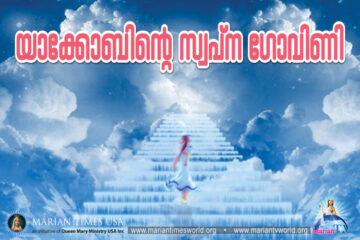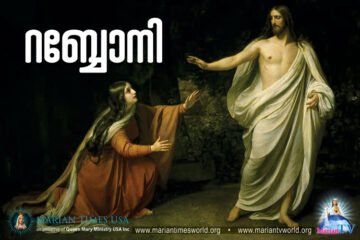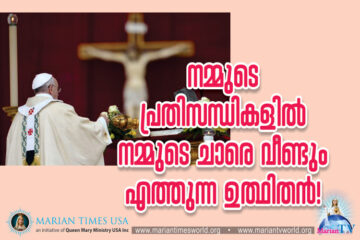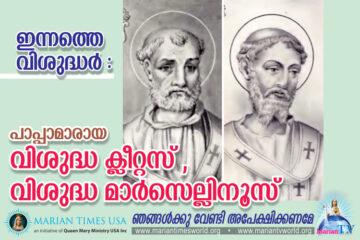REFLECTION FOR THE FEAST OF OUR LADY OF GUADALUPE
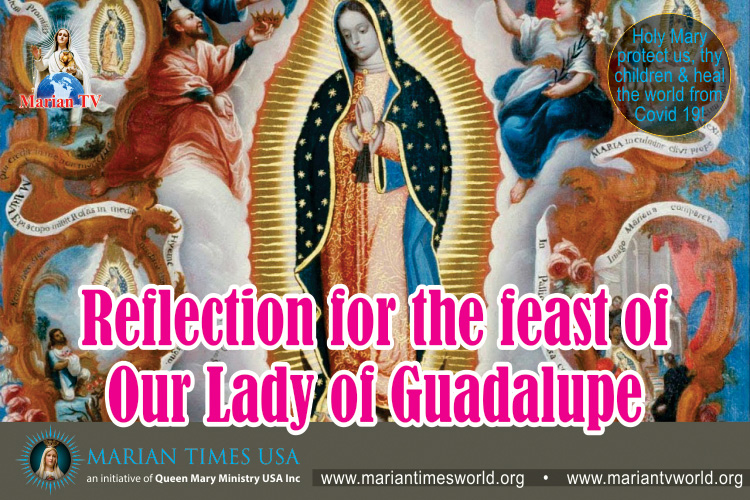
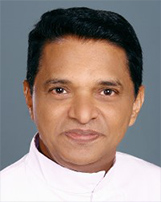
~ Fr. Abraham Mutholath ~
Chicago, USA. ~
INTRODUCTION
The Basilica of Our Lady of Guadalupe is the greatest Marian Shrine in the world. It is based on the apparition of the Blessed Virgin Mary four times to St. Juan Diego and one time to his uncle Juan Bernardino from December 9 to 12, 1531. The handwoven mantle of Juan Diego on which the image of Our Lady was supernaturally imprinted as a proof for the local Bishop Zumarraga is still fresh and displayed in the Basilica of Our Lady of Guadalupe in Mexico. This miraculous and unique image of the Blessed Mother has great communicative value because of its divine origin and symbolic meanings. This image attracted many throughout five centuries and made revolutionary spiritual and social changes in Mexico.
Bible Text: (Revelation 11:9a, 12:1-6a, 10ab)
(Rev. 11:19a) Then God’s temple in heaven was opened, and the ark of his covenant could be seen in the temple. (Rev. 12:1-6a) (1) A great sign appeared in the sky, a womanclothed with the sun, with the moon under her feet, and on her head a crown of twelve stars. (2) She was with child and wailed aloud in pain as she labored to give birth.(3) Then another sign appeared in the sky; it was a huge red dragon,with seven heads and ten horns, and on its heads were seven diadems. (4) Its tail swept away a third of the stars in the sky and hurled them down to the earth. Then the dragon stood before the woman about to give birth, to devour her child when she gave birth.(5) She gave birth to a son, a male child, destined to rule all the nations with an iron rod. Her child was caught up to God and his throne.6)The woman herself fled into the desert where she had a place prepared by God, (Rev. 12:10 ab) Then I heard a loud voice in heaven say: “Now have salvation and power come, and the kingdom of our God and the authority of his Anointed.”
Our Lady of Guadalupe
Historical Background
The apparition of the Blessed Virgin Mary in Guadalupe, Mexico needs to be understood in the historical background of Mexico. People started to migrate in Mexico around 13,000 years ago. When the Spanish forces under Captain Hernando Cortes arrived to Veracruz, south-east of Mexico Cityfrom Cuba on April 22, 1519,the Aztec emperor Montezuma II was in power. There were 10 million inhabitants in Mexico divided into 38 provinces and ruled by governors under the emperor. Cotes waged war against the emperor for two years and took control of the empire. The native people oppressed by the emperor also joined the Spaniards in the fight against the emperor. The surrendered soldiers of the emperor were also used by the Spaniards to continue war against the emperor’s army. The emperor tried for settlement with the Spaniards. After several days of negotiations, Cortes arrested the emperor and killed him because he did not trust the emperor. Mexico was then incorporated under the Spanish crown.
After the conquest of Mexico, Captain Hernando Cortes tried to introduce the European culture among the natives in Mexico. He demolished the temples of human sacrifices and built Catholic churches over the destructed pagan temples. Missionaries were brought from Spain. They opened churches, schools, and hospitals in Mexico. Though there were few conversions to Christianity, the missionaries could not eradicate the centuries old Aztec culture and pagan worship.
Hernando Cortes left for Honduras in 1524. His successor, the representative of Spanish Emperor Charles V, found it hard to manage the situation in Mexico. So in 1528 he was replaced by a team of five administrators known as the First Audience. Spanish emperor Charles V appointed a Franciscan Bishop Zumarraga to Mexico with considerable powers over the First Audience to control their misuse of power over the natives in Mexico. This first bishop of Mexico worked hard for the evangelization and social welfare of the natives. However, the deep rooted idol worship of the natives and the cruelty of the Spanish administrators were a backslash in the evangelization effort of Bishop Zumarraga and his team of missionaries from Spain.
Don Nune de Guzman, the dominant person of the First Audience began to turn against Bishop Zumarraga and other Christian missionaries because they did not agree with his cruelty to the natives. Guzman thought that the natives were soul-less and he treated them with inhuman cruelty. Finding no chance of compromise with Guzman, Bishop Zumarraga secretly reported the situation to the Spanish Emperor Charles V. So the emperor replaced the First Audience with a Second Audience headed by Bishop Don Sebastian Ramirez y Fuenleal. However, the new administrators could reach Mexico only a year after their appointment.
Meanwhile, the Aztecs along with other tribes in Mexico took arms against the cruelty of Spaniards. Bishop Zumarraga could sense that the rebellion could lead to great destruction of Spaniards. He prayed to Blessed Virgin Mary to intervene and to save the few Spaniards in the country. He secretly asked Mother Mary to send him some Castilian roses that are not available in Mexico as a sign of hearing his prayer.
The Apparition of the Virgin
Juan Diego, his wife Maria Lucia, and his uncle Juan Bernardino were converted to Christianity in 1525. Since Diego’s parents died when he was young, his uncle Bernardino was his foster father. After his marriage, Juan Diego moved to a different house. Juan and his wife used to walk 15 miles to his parish atTlaltelolco to attend Holy Mass and religious education class. Maria Lucia died in 1529. Since he was childless and his uncle needed care, Juan moved to a house near his uncle’s house.
On Saturday, December 9, 1531, Juan Diego, then age 57, was going to his parish church in the early morning to take part in the feast of Immaculate Conception. While passing through Tepeyac Hill he saw birds on the summit and heard a celestial music. He also saw a white cloud and rainbow. Then he heard a feminine voice calling him by name and asking him to ascend. Juan went up the 130 feet mountain top and saw the Lady. She said “Know for certain, dearest of my sons, that I am the perfect and perpetual Virgin Mary, Mother of the True God, through whom everything lives. … Here I will hear their weeping and their sorrows, and will remedy and alleviate their sufferings, necessities and misfortunes.” The Lady then asked him to tell the Bishop of Mexico City to build a shrine in her name on the spot where she appeared.
The bishop’s staff did not allow Juan Diego to see the bishop because he was a native. After long waiting, he was allowed to visit Bishop Zumarraga who with the help of Juan Gonzalez, a Spanish missionary among the natives and interpreter, listened to him. However, the bishop asked Juan to come again so that the bishop would have more time to consider the request. Juan went back to the top of the Tepeyac Hill where Our Lady was waiting for him. Juan said the bishop did not believe him and he suggested the Virgin to assign someone of higher status for her mission to the bishop. The Lady asked him to visitthe bishop the next day.
On the next day, Juan Diego went after Sunday Mass to see the bishop. After much waiting, the staff of the Bishop’s house allowed him to see Bishop Zumarraga. This time the bishop asked for a sign from the Lady to prove the credibility of the vision. Bishop Zumarraga secretly sent his trusted aides to follow Juan and verify the fact. Though they followed Juan, they missed him on the hill. Juan Diego again met the Virgin at the hill and explained what the bishop had asked him. The Lady told him to return to her the next day.
On his return home, Juan found that his 68-year-old uncle Juan Bernardino, was terminally ill. It is believed that Bernardino was shot by Spanish opponents because he collaborated with the Spanish missionaries. Juan sought the help of a village physician to treat his uncle. But the herbal treatment did not find any good result. Juan Diego did not go to the Lady the next day (December 11thMonday) because he was taking care of his sick uncle. On Tuesday early morning, Juan’s uncle wanted Juan to go to the local church and get a priest for his confession and last rites. Juan took a deviation as he approached the hill in order to avoid seeing the Lady from heaven so that he could get a priest before his uncle died. However, the Lady came down from the Tepeyac Hill to meet him on the way. She assured him that his uncle was cured at that moment and asked him to go up the hill where she met him three times before and gather the flowers from there and bring back to her. Though flowers could not grow at winter and on a rocky place, Juan Diego found flowers including Castilian roses that were not common in Mexico. He brought the flowers on his tilma (mantle) and showed to the Lady who rearranged them and asked Juan to take them to the bishop as a sign.
At the same time, Juan’s uncle Juan Bernardino also had a vision of the Lady who cured him and told him what was going on with Juan Diego and also revealed him that she should be titled as “The Ever Virgin, Holy Mary of Guadalupe.” Bishop Zumarraga, when he later heard this, was surprised because this name corresponded to a historical Marian shrine of his native country, Spain.
When Juan reached the Bishop’s house, the staff again tried to avoid him seeing the bishop. He stayed there long with the flowers covered with his mantle. Later he was allowed to meet the bishop. There were somepeople there including the new governor of Mexico Bishop Don Sebastian Ramirez Fuenleal. Juan while explaining what happened with his forth vision of the Lady, opened his tilma to show the flowers. The flowers along with Castilian roses fell on the floor. Bishop Zumarraga was amazed to see the Castilian flowers, a sign he had asked the Blessed Virgin Mary as sign of resolving the conflict between the native people and the Spaniards. Moreover, he saw an image of the Blessed Virgin on the tilma that Juan was unaware at that time. Bishop Zumarraga fell on his knees to honor the Lady. He embraced Juan and asked forgiveness for not believing him before.
This tilma of Juan was made of maguey cactus fibers with three pieces joined together. The miraculous image was imprinted on two pieces six-and-a-half feet long by 42 inches wide with a joint running down the middle. Though such a mantle has a life span of 10 to 30 years, it still remains with same freshness even after five centuries. It survived the unsafe exhibition without any glass covering and touch by bare hands and weapons by millions of pilgrims. Smoke from thousands of candles and dust from the stone chapel did not lessen the brightness of the image. Pilgrims who prayed in front of the image received many miracles and favors. The tilma survived an accidental acid spill in 1785while cleaning the frame holding the tilma, and a purposeful bomb blast to destroy the image in 1921. Dr. Callahan who studied the tilma using infrared technology in 1979 discovered that the tilma maintains a constant temperature of 98.6 degrees Fahrenheit the same as that of a living person.The image is displayed at the back of the sanctuary of the Basilica of Our Lady of Guadalupe in Mexico attracting pilgrims from all over the world.
Interpretation of the Image of Guadalupe
When people were illiterate, pictographs were used to educate them. The image of Our Lady of Guadalupe is a perfect pictograph well understood by native Mexicans. The uniqueness of this pictograph is that it is of divine origin and was not painted by human hands. It has no brush strokes, no primer or over coating with varnish. No fungus or insects could damage the sack like tilma even after 500 years. The clarity of the image is still vibrant. Modern scientists accept that this image is beyond scientific explanation. Some of the interpretations of the image are as follows:
1. The Lady in front of the sun
Aztec Interpretation:For Aztecs, sun is a prominent god called Huitzilopochtli. The pregnant virgin stands eclipsing the sun indicating that she is introducing the real God greater than the sun.
Christian Interpretation:Usually the halo of a saint is only around the head. For Our Lady of Guadalupe, it is all around her body reminding us the greeting of Angel Gabriel, “Hail full of grace.” (Luke 1:28). John describes his vision at the Island of Patmos: “A great sign appeared in the sky, a womanclothed with the sun, with the moon under her feet.” (Rev. 12:1a). In the image of Guadalupe that is what we see.
2. Mary “with the moon under her feet” (Rev. 12:1b)
Aztec Interpretation:The moon for the Aztecs is the feathered serpent-god Quetzalcoatl. This moon-god was for the native Mexicans the god of night.
Christian Interpretation:Mary stepping on this serpent god (dark moon-god) means she has crushed and defeated this god of darkness, fulfilling God’s word in Genesis 3: 15.
3. The clouds around the sun and moon
Aztec Interpretation:The clouds around the Virgin is representingthe divine origin of Mary’s son. The natives greeted people from God with the expression: “Among the fog and among the clouds.”
Christian Interpretation:In the Bible, cloud is a symbol of the Divine presence. (Exodus 16:10; 33:9; Numbers 11:25; 12:5; Job 22:14; and Psalms 18:13).
4. The long greenish-blue mantle with stars
Aztec Interpretation: The greenish-blue color was the color worn by Aztec royal people. Therefore, Mary is a royal lady, a queen. For the Aztecs stars are gods. But in the image of Guadalupe, stars are only decoration on the mantle of the Lady. So she is greater than the star-gods and she comes from the heaven.
Christian Interpretation:The long robe is not the style of dress for Mexican women but a Jewish dress of women in Palestine. So Mary is of Jewish origin.
5. Rose-colored garment
Mary’s rose-tinted garment with flowers embossed on itis symbolic of the earth. So the heavenly color of her mantle with stars and the earthly color of her garment indicate that the God she is introducing is both divine and human.
6. An angel with eagle’s wings carrying the Lady
An angel supporting the Lady signifies that she is a queen. Only royal people were carried on the shoulders of someone in the native Mexican culture. Unlike the angels in the regular Christian art works, this angel is adult looking and has wings of an eagle. Eagle was the “bird of the sun” that delivered to the sun-god the hearts and blood sacrificed on the pyramids. The angel is holding the pregnant Virgin, signifying that the child in her womb is the perfect sacrifice offered to God. The angel’s tunic has the same color of Virgin’s tunic and wears a broth like hers. The angel holds Virgin’s mantle with one hand and the garment with the other indicating that the Son she bears is from both heaven and earth.
7. The hair style
The hair parted in the middle and hanging loosely is the conventional hair style of virgins in the Aztec culture. Virgin Mary has the same hair style in the image signifying that she is a virgin.
8. Eyes cast down
The gods of the native people look straight ahead with their eyes wide open. However, in the image of Guadalupe, the eyes of the Virgin are looking down with humility and compassion. From this image, the natives understood that Mary was not a goddess.
Modern scientific studies by ophthalmologists have proved that the eyes of the image are not paintings but human eyes. They have reflections of 13 people including Juan Diego and Bishop Zumarraga. No human painter can or will do such a work.
9. Olive complexion with rosy cheeks
Thefacial color of the image varies at different distances. It has the color of the natives at one distance and the color of European at another distance. This is a special feature not seen in any painting but only in certain flies. Thus it is a blend of two cultures: the natives and the Spaniards.
10. Cross on the medallion
Mary is wearing a gold medallion around her neck with a small cross engraved on it. For the native Mexicans, medallion is a symbol of consecration. Mary is consecrated to her son Jesus. This cross was also the symbol of the Spanish sale ships and the Catholic Missionaries. Mary wants the natives to welcome the Spaniards, their missionaries and their God.
11. Hands joined and knee bent
Mary’s hands joined in prayer indicates that she is not a goddess but subject to God. Her hands point to the cross on her brooch. Her son Jesus is greater than her. So the pilgrims visiting her are directed to her son Jesus.
The prayer of the natives was expressed by their whole body. Like them, Mary is shown in a position of dancing prayer with her knee bent in movement.
12. Black ribbon around the waist
The black girdle around Mary’s waist shows that she is expecting a child. It was the traditional dress code of pregnant women in that culture.
13. Four-petal jasmine flower
A jasmine flower with four petals appears on Mary’s garment over her womb. It represents the Aztecs’ highest deity, Ometéotl. This flower over the womb or the center of the image shows that the one true God born of a virgin is the center of the universe.
14. The four petal flowers with leaves
According to Aztec “Legend of Five Suns,” this world has five life cycles. When each cycle of the world is ended, it is reborn through the sacrifice of a god because the god’s sacrifice creates a new sun, which in turn creates a new world. The four petal flowers on the tunic of the Lady show that it is time for the fifth age through the sacrifice of the real God.
15. The eight petal flowers
The eight petal flowers imprinted on the tunic with hill and river flowing from themsymbolize the day of a new creation. For the natives, hills were the high point where God and people meet. This flower when viewed upside down, take the shape of a heart with arteries that is the source of life originating from God.
The impact of the Image of Guadalupe
1. Enmity of Spaniards and Natives ended
Spaniards and Mexicans volunteered to construct a small stone chapel where Blessed Virgin asked to build a church. The image of Guadalupe was taken in procession to this chapel on December 26, 1531. During the procession, some people shot arrows into the air out of excitement. One of them struck the neck of a spectator and he was killed. People took the dead man’s body in front of the image and prayed for a miracle. The dead man opened his eyes and was fully recovered. Out of joy, the Spaniards and Mexicans embraced one another. This led to a gradual merging of the two cultures with intermarriage and harmonious life.
2. Replacing of mother-goddess with Mother of the True God
Tepeyac Hill, where the Blessed Virgin appeared, was the site of the temple of the Mexican mother-goddess Tonantzin. Spanish Captain Juan Cortes had destroyed it. The people who used to worship the mother-goddess substituted that with Mary, the Mother of God in the same place.
3. Destruction of the Serpent god.
For Spaniards, Guadalupe means a shrine of the Virgin Mary in Spain. However, for the natives it sounded like “she who crushes the serpent.” “I will put enmity between you and the woman, and between your offspring and hers; They will strike at your head. while you strike at their heel.” (Genesis 3:15). God’s word to the serpent came true in Mexico. The serpent god Quetzelcoatl to whom many human sacrifices were offered in Mexico, was the Satan that was destroyed by the apparition of the Blessed Virgin Mary. People left this god and received Jesus through baptism.
4. Laymen ministry started with Juan Diego
Bishop Zumarraga assigned Juan Diego in charge of the chapel built at Tepeyac Hill. Juan introduced Catholic faith to all the pagan Mexicans who came to venerate the image of Our Lady of Guadalupe while explaining the story behind the image in their native language. He then sent them to Christian missionaries for baptism. Thus Juan Diego became the first lay missionary who made mass conversion possible.
5. Mass conversion to Catholic Faith
The Catholic Church had lost five million (5,000,000) faithful because of Protestant Reformation in Europe. At the same time Blessed Virgin of Guadalupe gained nine million Aztec converts to Catholic faith. The honor given to the Blessed Virgin Mary was denied by the protestants. Whereas, she gained the respect and honor by double that number in Mexico.
6. The end of pagan worship and human sacrifice
The Aztec towns were built around stone pyramid-shaped temples where they had their religious ceremonies. The native people worshiped sun, moon, fire, rain, wind, corn, maguey cactus and others as gods or goddesses. Besides offering agricultural products and animals, they offered human sacrifices to these gods to avoid natural calamities. Aztecs considered themselves as “the people of the sun.” They used to offer human heart on the temple top to nourish the sun god so that the sun will not fail to rise on the next morning. Salves, prisoners of war, and children were killed to offer the human sacrifice. Thousands were sacrificed to the mightiest god Quetzelcoatl a feathered stone serpent. Mary, the Mother of the Son of Man crushed this serpent ending human sacrifices and established the kingdom of her son Jesus in Mexico. What the Spanish missionaries could not do for 10 years was achieved fast by the miraculous image of Our Lady.
Message
- Blessed Virgin Mary intervenes in times of crisis when we seek her help. The Christian denominations who do not honor Mary miss her powerful intercession before God.
- Many Christian denominations teach against the perpetual virginity of the Blessed Virgin Mary. In her apparition to Juan Diego, Mary revealed that she is “the perfect and perpetual Virgin.”
- Mary promised to Juan Diego that at the Tepeyac Hill she “will hear their weeping and their sorrows, and will remedy and alleviate their sufferings, necessities and misfortunes.” Thousands have been going there since five centuries with their sorrows and getting relief through the intercession of the Blessed Mother.
- Juan Diego was not treated well by the staff of Bishop Zumarraga until the miracle happened. God loves the poor and represents Himself through them is clear from the teaching of Jesus onthe final judgement. (Matthew 25:31-46). We need to reconsider our approach towards the less fortunate in the society because they are valuable people of God.
- Bishop Zumarraga is considered as a devoted and dedicated missionary bishop who offered great service to the natives in Mexico. His doubt on the apparition and request for proof resulted in the miracle on Tilma and increased the credibility of the apparitions of the Blessed Mother.
- Cruelty of the Spanish administrators toward the natives was the hurdle for Spanish missionary work. Love and kindness should be the language of evangelization and pastoral ministry.
- Vision to a peasant was more credible than a direct communion of the Blessed Virgin to the bishop. The native people in Mexico trusted the one among them who had the apparition of the Blessed Virgin, who could speak their language and understand their culture than the foreign missionaries. Like Jesus who humbles himself to be one among humans, a missionary or a pastoral minister should become one among the people he preaches.
- St. Juan Diego was the first lay missionary who converted a great number of people to Catholic faith. We need to promote lay missionaries who can do excellent ground work for pastoral service.
മരിയന് ടൈംസിലെ ഇന്നത്തെ പ്രധാനപ്പെട്ട അപ്ഡേറ്റുകള് താഴെ ലഭിക്കുന്നതാണ്.


